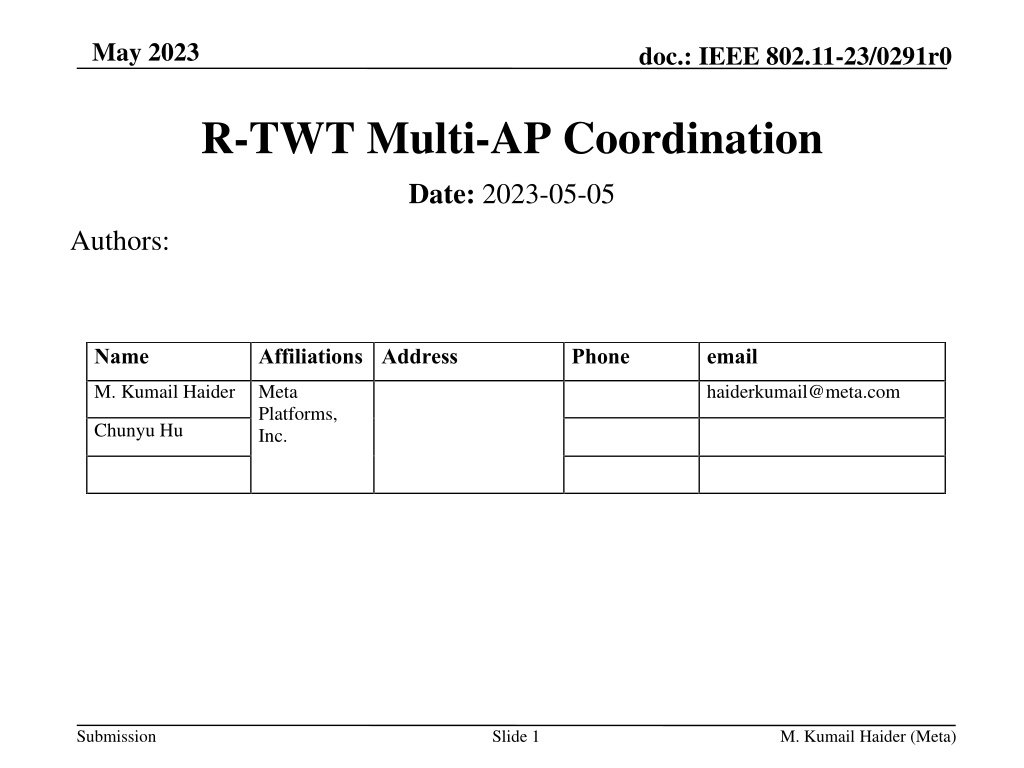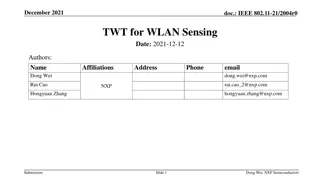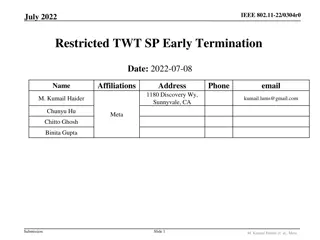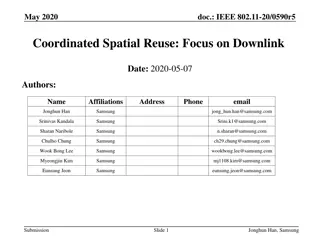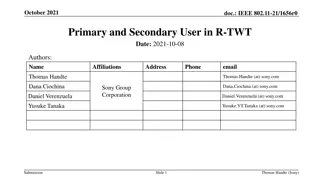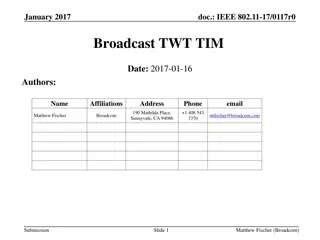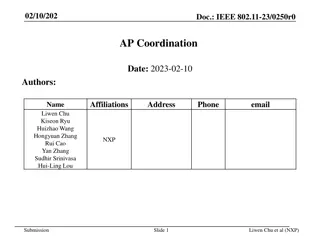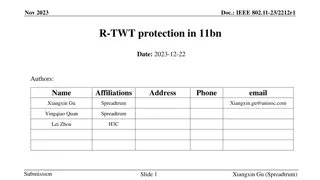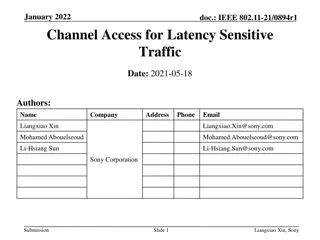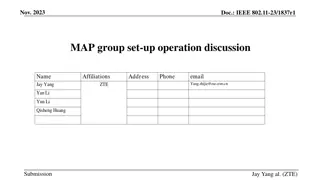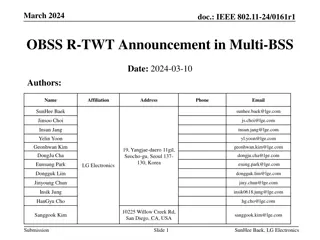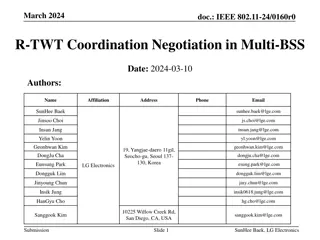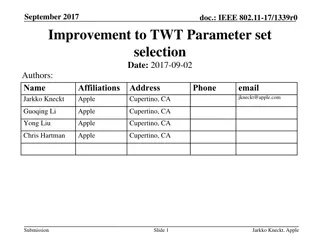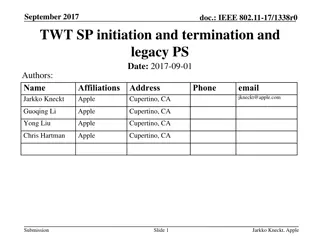Enhancing R-TWT with Multi-AP Coordination in IEEE 802.11 Networks
Delve into the world of IEEE 802.11 wireless networks as this document explores solutions for multi-AP coordination for R-TWT, focusing on improving tail latency, jitter, and medium protection. Enhancements in R-TWT operation, coordination scenarios, and solutions for multi-AP deployments are discussed to optimize latency-sensitive applications across overlapping BSS environments.
Download Presentation

Please find below an Image/Link to download the presentation.
The content on the website is provided AS IS for your information and personal use only. It may not be sold, licensed, or shared on other websites without obtaining consent from the author. Download presentation by click this link. If you encounter any issues during the download, it is possible that the publisher has removed the file from their server.
E N D
Presentation Transcript
May 2023 doc.: IEEE 802.11-23/0291r0 R-TWT Multi-AP Coordination Date: 2023-05-05 Authors: Name Affiliations Address Phone email M. Kumail Haider Meta Platforms, Inc. haiderkumail@meta.com Chunyu Hu Submission Slide 1 M. Kumail Haider (Meta)
May 2023 doc.: IEEE 802.11-23/0291r0 Problem Statement UHR is aiming for improving tail latency and jitter compared to 802.11be including scenarios of overlapping Basic Service Sets (BSSs) R-TWT is a suitable candidate from 802.11be for providing enhanced medium protection and predictable latency for latency sensitive applications Coordination among neighboring BSSs can further enhance R-TWT operation and medium protection This document explores candidate solutions for multi- AP coordination for R-TWT Submission Slide 2 M. Kumail Haider (Meta)
May 2023 doc.: IEEE 802.11-23/0291r0 Recap: R-TWT Operation in 802.11be Uses broadcast TWT (802.11ax) signaling as baseline, with enhancements AP advertises R-TWT schedules via TWT element in Management frames in the BSS (e.g., Beacon, Probe response) Indication of R-TWT UL/DL TIDs during membership setup to identify latency sensitive traffic Provides enhanced medium access protection and provisions for predictable latency R-TWT supporting STAs must end any TXOP at SP start boundary Optional usage of overlapping quiet intervals to limit interference from legacy (non-EHT) devices Prioritization of traffic belonging to R-TWT UL/DL TIDs per membership Spec recommends membership negotiated as Trigger-enabled for efficient medium access Submission Slide 3 M. Kumail Haider (Meta)
May 2023 Next: Extending R-TWT for Multi-AP deployments in UHR doc.: IEEE 802.11-23/0291r0 Several contributions in UHR have discussed R-TWT enhancements with multi- AP coordination 11-23/0226r0: Coordination of R-TWT for Multi-AP Deployment, Abdel K. Ajami (Qualcomm) et.al. 11-23/0250r0: AP coordination with R-TWT, Liwen Chu (NXP) et.al. 11-23/0970r0: rTWT for Multi-AP, Laurent Cariou (Intel) et.al. This contribution shares our view and introduces further discussion on this topic Submission Slide 4 M. Kumail Haider (Meta)
May 2023 Extending R-TWT with Multi-AP Coordination Solution doc.: IEEE 802.11-23/0291r0 R-TWT in 11be focuses on building the basic signaling and solution for single BSS case. It s a first step. To scale up its effectiveness in wider deployments, we should consider tackling the problem further in multiple BSS environments R-TWT schedules outside of multiple or co-hosted BSSID sets are currently not advertised inside an AP s BSS Interference from OBSS could result in delay in medium acquisition by member R- TWT STAs from SP start time, if OBSS traffic continues into the SP, delaying delivery of latency sensitive traffic The peer-to-peer(s) link, esp. when none of the STAs are associated with the infra- AP, also falls into this multi-BSS/OBSS scenario, and would benefit from a solution in this direction R-TWT SPs in neighboring BSSs could overlap in time, resulting in reduced medium access efficiency. Coordination in usage of SPs will help mitigate contention and improve predictable delivery of low latency traffic Submission Slide 5 M. Kumail Haider (Meta)
May 2023 doc.: IEEE 802.11-23/0291r0 R-TWT Schedule Coordination Neighboring APs may exchange R-TWT schedule information and advertise OBSS schedules in their respective BSS R-TWT supporting STAs in neighboring BSSs follow the R-TWT SP start time protection rule, suppressing OBSS interference An AP may consider OBSS schedules when devising schedules in its own BSS (implementation dependent or further rules TBD) AP coordination for allocation of resources within SPs Submission Slide 6 M. Kumail Haider (Meta)
May 2023 doc.: IEEE 802.11-23/0291r0 Modes of Schedule Coordination Two types of schedule coordination: 1. OBSS schedules: Announcing schedules from OBSS for SP start time protection R-TWT supporting STAs end any TXOP at SP start Non-interfering transmissions may still happen within the BSS (spatial reuse) AP1 announces AP2 s R-TWT schedules in its BSS in beacons *AP1 and AP2 may exchange schedule info on the same or different channel, or on a backhaul link R-TWT SP start AP1 may respond to STA11 if its inter-BSS NAV is not set beacon AP1 BA BA AP1 AP2 STA11 initiates TXOP as it is not suppressed by AP2 s TX DATA STA11 STA12 ensures its TXOP ends at R-TWT SP start boundary STA12 doesn t initiate further TXOP as it defers to transmissions in BSS2 DATA STA12 R-TWT SP STA12 AP2 BA+DATA Trigger STA2 STA11 BA DATA STA2 *Assuming all APs and STAs support R-TWT Submission Slide 7 M. Kumail Haider (Meta)
May 2023 doc.: IEEE 802.11-23/0291r0 Modes of Schedule Coordination Two types of schedule coordination: 1. OBSS schedules: Announcing schedules from OBSS for SP start time protection R-TWT supporting STAs end any TXOP at SP start Non-interfering transmissions may still happen within the BSS (spatial reuse) 2. Multi BSS schedules: APs may devise and announce coordinated schedules Reduces number of schedules being advertised/devised Schedule has the same TWT parameters (e.g., start time, duration, period) and advertised in respective BSSs STAs from multiple BSS may be members of this schedule (negotiated with respective APs) TXOP-level coordination for efficient medium access Submission Slide 8 M. Kumail Haider (Meta)
May 2023 doc.: IEEE 802.11-23/0291r0 Modes of Schedule Coordination Further thoughts on Multi-BSS schedules Having a joint schedule, which serves STAs in multiple BSS, may improve medium efficiency compared to advertising separate OBSS schedules where R-TWT supporting STAs have to end TXOP at start boundary of each schedule APs may coordinate using other features (e.g., enhanced spatial reuse) to allow multiple R- TWT scheduled STAs to be served concurrently in their respective BSSs to enhance efficiency (beyond the scope of R-TWT operation) AP coordination and triggered access will be key to prioritizing latency sensitive traffic delivery and reducing contention It may also be helpful with mobility/roaming. E.g., STA switching between APs in an ESS may remain member of the same schedule while handed over between APs. Any associated QoS Char IE etc. may also be retained (further signaling needed between APs) TXOP-level allocation within SPs can further improve STA s power saving and devise resource allocations that closely fulfil STA s requirements for latency sensitive traffic delivery Submission Slide 9 M. Kumail Haider (Meta)
May 2023 doc.: IEEE 802.11-23/0291r0 Signaling for Schedule Information APs may acquire schedule information in other BSSs: 1. Passively: By listening to beacons from neighboring BSSs 2. Actively: By sharing schedule information via a new individually addressed frame Frame could carry additional information about schedules helping with coordination Schedules may be shared and coordinated on before announcing in respective BSSs Could also be shared via a central management entity in ESSs TWT element already provides basis for schedule announcement o o o Restricted TWT Schedule Info field provides further info about advertised schedules value description Value 3 could be expanded to include OBSS/Multi- o BSS schedules o For such schedules, TWT element may carry an identifier for the originating BSS, or to identify between OBSS and Multi-BSS schedules 0 Idle 1 Active 2 Active, Full 3 Active, belongs to co-hosted/multiple BSSID set Submission Slide 10 M. Kumail Haider (Meta)
May 2023 doc.: IEEE 802.11-23/0291r0 Further thoughts on gaps in signaling Several signaling gaps were discussed in 802.11be and deferred to next round TID indication in Trigger frames and BSR Control field Basic Trigger frame can only indicate a Preferred AC, and not directly indicate a TID for soliciting UL For enhanced SP coordination within BSS and OBSS to solicit UL traffic, TID indication in Trigger frames will be useful Similar issue with AC level buffer reporting in BSR Control Explicit signaling for SP management becomes necessary R-TWT schedules may need to be extended in case R-TWT TID traffic is not delivered within the SP When coordinating and managing schedules in multiple BSS, this problem becomes even more relevant and critical Explicit signaling helps with better schedule management (SP termination and extension) Enhanced support for p2p traffic Member STA s p2p traffic could be provisioned via AP e.g., via enhanced TXOP sharing for more efficient medium utilization and coordination between infra and p2p link Signaling enhancements are needed to indicate requirements for p2p traffic and its delivery Submission Slide 11 M. Kumail Haider (Meta)
May 2023 doc.: IEEE 802.11-23/0291r0 Conclusion We introduced concepts and solutions for R-TWT schedule coordination between multiple APs in neighboring BSS to enhance R- TWT operation in UHR Two modes/levels of schedule coordination are identified We discuss existing and new signaling for advertisement of such schedules between APs and between AP and their associated STAs Extending R-TWT operation for multi-AP coordination will facilitate in mitigating OBSS interference during SPs and providing predictable latency for low latency traffic Submission M. Kumail Haider (Meta) Slide 12
